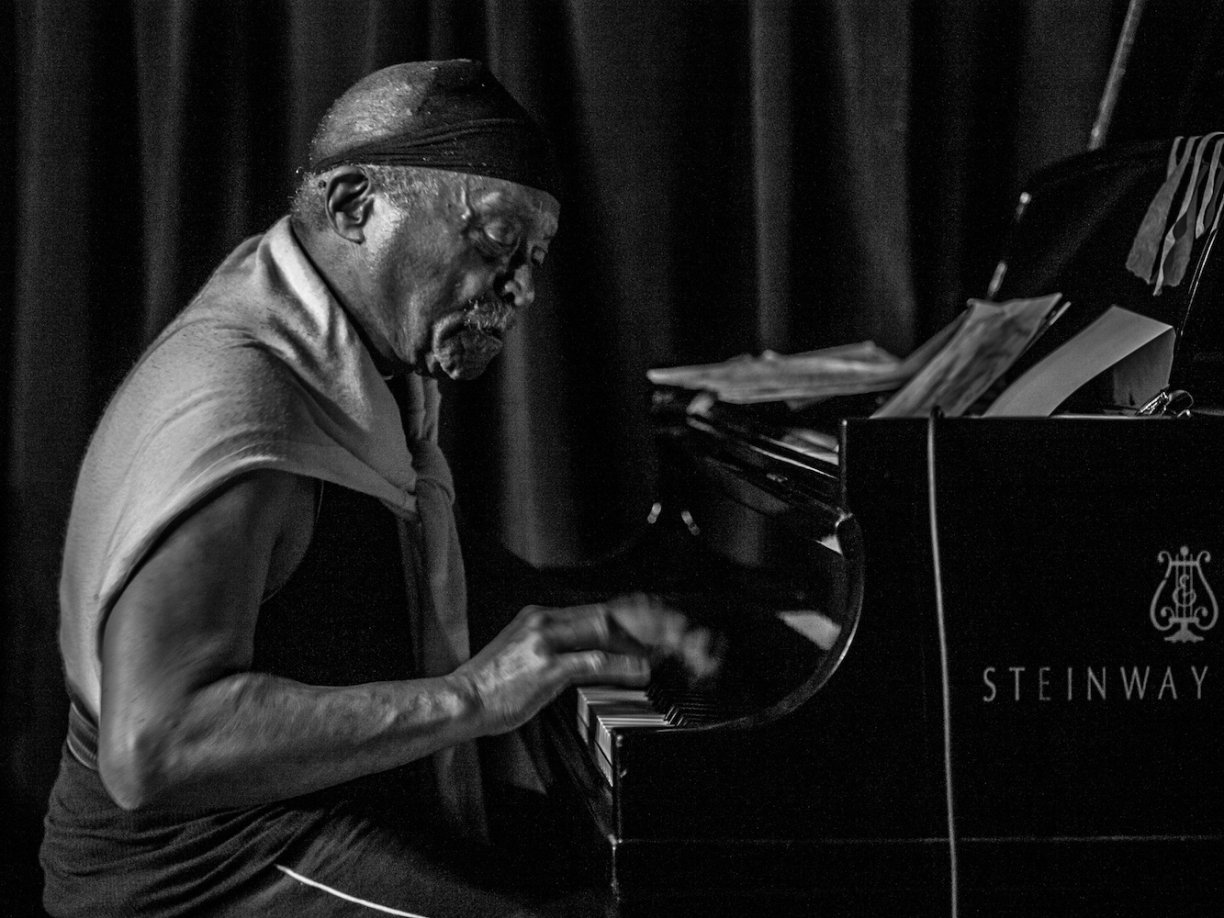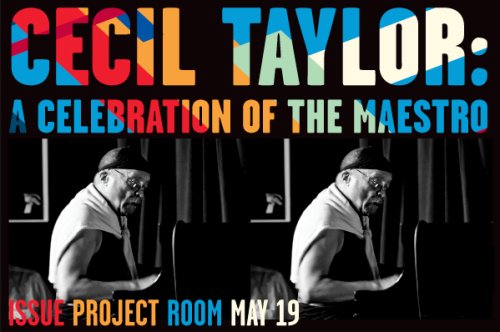by George Grella in the Brooklyn Rail, July-August 2012
http://www.brooklynrail.org/2012/08/music/cecil-taylor-home-at-last
Scenes from the landscape of my mind’s ear:
-December 1989, sitting next to my best friend at the time, young men drawn to exciting and daring artistic ambitions that we couldn’t quite understand. We’re in Town Hall, witnessing Cecil Taylor and Max Roach playing a concert celebrating the ten-year anniversary of their historic live recording at the Miller Theatre. We turn to each other, almost giddy with astonishment to find that we are crouched down, using the seats in front of us to protect ourselves from the torrential onslaught of ideas.
-In the early 1990s, the final iteration of Condon’s jazz club, Taylor and his Feel Trio, his very finest ensemble, played the small room in front of a tiny crowd. Two young Japanese tourists, guys, were sitting at the table in front of me. Taylor’s playing has always had a profound physical effect on me, as if he were reaching out to forcefully manipulate my shoulders and waist and head and thighs, making me bob and bounce and weave. But one of the young guys in front of me was immediately and intensely overcome, like a congregant at a charismatic service. He shook and shivered so sharply and violently that he eventually knocked over his table, spilling drinks in a loud crash. No one missed a beat, not the band, not the kid, not me. It seemed just what everyone expected.
-Other times, so many times, seeing Taylor play in New York and San Francisco, partly to half-empty halls, no matter the size, and many of the people who were there for the first notes streaming out. Me wondering, what the hell were they doing there? What did they expect, and how were they so confounded? How can someone go see Taylor—and what kind of person buys a ticket, often an expensive one—only because they had heard of the man without knowing that he is at the fine edge of the avant-garde, that he is one of the truly singular artists, defying social and musical culture to produce art unlike anything else?
Great and difficult artists go through an extended process of presenting themselves to the public and then waiting for their audience to form. Taylor has had a substantial following in Europe, with the very best of his recorded legacy released on the European labels FMP and Black Saint/Soul Note; his recordings on the latter, including the 1979 concert with Roach, were recently reissued in a no-frills boxed set with remastered sound that opens up and clarifies the original audio. However the U.S., and even New York, has been harder for him, and he’s been largely absent from the stage here so far this century. Maybe it took that time for local audiences to finally catch up with him, listen to his records, think about his art, and anticipate what he might be doing next. The audience for his May 19 ISSUE Project Room performance—part of the miniature festival “Cecil Taylor: A Celebration of the Maestro,” with events at Harlem Stage and Anthology Film Archives—was buzzing before his appearance and was riveted throughout his set. It was standing room only; nobody left, and everyone joined in the ovation at the close.
The concert had a strong and lovely homecoming feeling. Taylor has been a long-time resident of Fort Greene, Brooklyn, and this, amazingly, was his first public performance in the borough. It was also the most noteworthy event so far for ISSUE Project Room in its new, resonant space at 110 Livingston Street. While it doesn’t make up for the debacle of the Atlantic Yards development, it’s a noteworthy gift, the powers-that-be truly supporting the real avant-garde. City Council Member Steve Levin spoke before the concert, noting that the NEA had also made the event possible; Robert Longo and other board members were on hand; there was a scattering of critics and music professionals, most of whom had not seen Taylor play before. In fact, most of the audience, well balanced between young and old, had clearly never even seen the man in person before. The huge round of applause that greeted him as he stepped up to the piano was very much a celebration that we were all there, joining in witness.
Taylor, 83 years old, small, plays the piano with the same intense, furious physicality he’s had for the last six decades. One of the few signs of his age was that there was no encore, something new in my experience. When he read some of his poetry—he is a masterful poet, as abstract as John Ashbery and as logical as John Cage, with more metrical balance and rhythm than either—his articulation was frequently unclear. The words were full of ideas about geometry, astronomy, formulas from physics, fragments of metaphors, and his voice still has a fascinating timbre, dry and with a strong, old-fashioned Brooklyn accent. His readings have often been diffident in the past, but here he seemed almost bemused.
He’s clearly continuing to develop his playing, and it’s not premature to hear this as his late style, akin to those of Beethoven and Elliott Carter. Like them, Taylor has broken down his own methods into fine, discrete units and uses them as a sure foundation for expression that, in concentrated segments, is broad and deep-reaching. One of the features of his middle-period playing was duration (“Period 2” on the live The Tree of Life lasts almost 45 minutes), but his IPR set totaled less than an hour, spread over five pieces. However, the shorter duration of the pieces concentrated the performance, opening up a range of intellectual and abstract exploration as rich and expansive as many hours of playing.
This is late style: the seemingly effortless organization of material, assembling and reassembling sections of music with a mercurial quickness that belies the weight of the ideas; a transparent and far-seeing sense of structure that at the final moments brings together what might have seemed scattered and accidental into a succinct, coherent, and powerful whole, like the finale of “Nights of Cabiria”; an overall thinning of what were previously dense and massive keyboard textures, revealing the blues and the hard nuggets of rolling boogie-woogie that are at the root of Taylor’s music.
One of Taylor’s most characteristic gestures is a quickly moving phrase that rocks back and forth from higher to lower notes as it rises along the keyboard. Taylor used to end this by briefly holding the penultimate notes, adding tension, but now it drifts away, lightly and lyrically, with a very strong flavor of the piano music of Ravel. It was a noticeable part of his relatively short opening work and was consistent in his playing throughout the evening, especially in the third piece. Taylor is not playing like Ravel, but he’s playing with some of the same values, using quick and misleadingly delicate phrases amidst a Romantic soundscape, teasing the listener mischievously as a way to hint at some dark power in the soul of the music, like the beguiling and frightening devil at the heart of Gaspard de la Nuit.
The bluesy-ness was strong in Taylor’s second piece, and so were the strong modal harmonies, another new and surprising development. He has always been an incredibly coherent player, especially considering how much he uses force as an aesthetic element, but the new elements make his structures easy to hear, and that has a profound effect on the feel of his expression. Taylor in the past has consistently gone into deep, extra-musical territory, blazing a path into outer regions by digging deep inside himself, carving a hole into another dimension from the inside rather than taking a rocket out to the edge of the universe. By lightening his textures and shaping clear, pithy harmonic motion, he has the effect of turning from an introvert into an extrovert, from a witch doctor tempting the spirits of the Cthulhu mythos to an architect pointing out the success of a design. In conjunction with his poetry, he is revealing formal beauty, while before the emphasis was, at least in the expressive sound, on emotional beauty. And the beauty is considerable.
Each piece reinforced this point past the previous one. By the fourth work of the concert, this new expression was clear and purposeful, not just a whim or mood of the night. Taylor laid out what for him was an abundance of not just harmonic motion but of establishing and modulating to and from different keys. There were quiet touches of Schumann, a songfulness breaking free of the strictures of song-form. He developed enough structure to define a clear coda, restating some of the previous material he had spun out, this time in compressed form, and marking off a gently logical ending. His final, short piece was declarative, like a fanfare, putting the period to what is a new chapter in his career.
It makes sense to hear and think about Taylor this way. He began playing at the periphery of jazz, and it’s not hard to hear the line of thinking that connects him to Duke Ellington’s piano playing. But he’s also left the idiomatic language of jazz rhythm and phrasing long behind, becoming an improvising artist. But that’s not quite right either. Of course he improvises, but he’s not a purely free player; instead he has crafted harmonic, rhythmic, and gestural material that he uses as a tool kit, combining and recombining on the fly to compose spontaneous pieces. There is room for plenty of improvisation in them, but he’s still building them. And he is a rare genius at it.
Taylor’s power and intensity have always been clear and prominent, and it seems to me that, like a flame is to moths, it’s those elements that have both drawn audiences and forced so many away, afraid. Taylor is not a gentle player, but there is a more companionable aspect to him, as if part of him is joining us in listening to, following along with, and enjoying the works he creates. It seemed, this one night, that his late style is welcome, most of all, to himself, that he enjoys the beauty and wisdom in it more than any of us in the audience did. That could be his own personal reward for appearing in his hometown, in front of a dedicated and adulatory audience. It was certainly ours.
by George Grella in the Brooklyn Rail, July-August 2012
http://www.brooklynrail.org/2012/08/music/cecil-taylor-home-at-last


